Backcountry snowboarding offers a unique thrill that combines adventure, solitude, and the beauty of untouched nature. For many riders, the allure of deep powder and pristine landscapes is irresistible. However, venturing beyond groomed trails requires preparation, knowledge, and respect for the mountain environment. In this article, we will explore essential techniques, gear recommendations, safety considerations, and tips for enjoying the ultimate backcountry experience.
1. Understanding Backcountry Snowboarding
Backcountry snowboarding refers to riding in areas that are not maintained or controlled by ski resorts. These untouched terrains provide endless opportunities for exploration and adventure. Unlike traditional snowboarding, backcountry riding requires a different mindset and skill set, as riders navigate through varied and often challenging conditions.
2. Essential Gear for Backcountry Adventures
Choosing the right gear is crucial for a safe and enjoyable backcountry experience. Here’s a list of essential equipment:
– Splitboard: A splitboard is designed to be used as both a snowboard and two skis for uphill travel. This versatility allows riders to ascend mountains efficiently and enjoy a smooth ride on the descent. Ensure that your splitboard is equipped with reliable bindings and climbing skins to maximize your uphill performance.
– Avalanche Safety Gear: Carrying avalanche safety gear is non-negotiable. This includes a beacon, shovel, and probe. Familiarize yourself with how to use each piece of equipment before heading out. Regular practice in mock rescue scenarios can save lives.
– Backpack: A good-quality backpack specifically designed for backcountry riding is essential. Look for one that accommodates your gear comfortably and includes features like hydration systems and compartments for avalanche safety equipment.
– Layered Clothing: Dressing in layers helps regulate body temperature during varying levels of exertion and weather conditions. Base layers wick moisture away from the skin, while mid-layers provide insulation. An outer layer should protect against wind and moisture.
3. Techniques for Backcountry Riding
Backcountry snowboarding involves different techniques compared to resort riding. Here are some key skills to develop:
– Navigation Skills: Familiarize yourself with maps, GPS devices, and navigation apps to understand the terrain and plan your routes. Being able to read topographical maps is essential for identifying potential hazards and safe zones.
– Uphill Climbing: Mastering uphill techniques is vital for backcountry exploration. Use your splitboard’s climbing skins to grip the snow and practice your stride. Keep your weight centered and maintain a steady pace to conserve energy.
– Powder Riding: Riding in powder requires different techniques than on groomed trails. To float on top of deep snow, shift your weight back slightly and keep your knees bent. This stance helps prevent the nose of your board from diving.
– Making Turns: In powder, turns should be wider and more fluid. Practice initiating turns with a gentle shift of your weight, allowing the board to naturally carve through the snow. Stay relaxed and let your body follow the movement of the board.
4. Safety First: Avalanche Awareness
Avalanche safety is paramount in backcountry snowboarding. Understanding avalanche risk and terrain assessment can make all the difference:
– Check Avalanche Forecasts: Before heading out, consult local avalanche forecasts to assess conditions. Familiarize yourself with avalanche danger ratings and how they affect your planned route.
– Choose Terrain Wisely: Avoid slopes that exceed a 30-degree angle during high avalanche risk. Look for open glades or gentle slopes where trees provide natural barriers and stability.
– Travel in Groups: Always ride with a partner or group in the backcountry. In case of an emergency, having multiple people increases the chances of a successful rescue. Establish communication protocols and keep a safe distance between riders.
5. Respecting the Environment
Backcountry snowboarding allows riders to connect with nature, so it’s essential to practice responsible riding:
– Leave No Trace: Follow Leave No Trace principles to minimize your impact on the environment. This includes packing out all trash, avoiding damage to vegetation, and staying on existing trails when possible.
– Wildlife Considerations: Respect wildlife habitats by avoiding sensitive areas and minimizing noise pollution. Be aware of seasonal closures and regulations designed to protect local ecosystems.
6. The Joy of Exploration
One of the most rewarding aspects of backcountry snowboarding is the sense of adventure and exploration. Every run presents a new opportunity to discover breathtaking views and untouched snow. Embrace the journey, whether you are ascending a peak or gliding down a fresh powder field. The solitude of the backcountry provides a unique connection to nature that can be both calming and invigorating.
7. Learning from Experienced Riders
If you’re new to backcountry snowboarding, consider joining a guided tour or taking a course. Experienced guides can provide invaluable knowledge about local conditions, terrain assessment, and safety practices. They can also help you build confidence as you navigate the backcountry.
8. Conclusion: Embrace the Adventure
Backcountry snowboarding is a thrilling way to experience the mountains while challenging your skills and connecting with nature. By investing in the right gear, mastering essential techniques, and prioritizing safety, you can enjoy the ultimate backcountry adventure. Remember to respect the environment and fellow riders as you carve your path through untouched snow. With every run, you’ll discover the joys of exploration and the beauty of the backcountry, creating memories that will last a lifetime.
